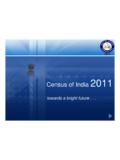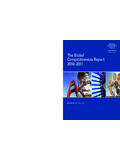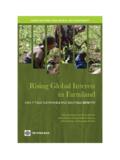Transcription of Cambodia Western Pacific Region - WHO
1 CambodiaWestern Paci c RegionI. Epidemiological pro lePopulation (UN Population Division)2017%High transmission (>1 case per 1000 population) transmission (0-1 case per 1000 population) free (0 cases) Parasites and vectorsMajor plasmodium : 58 (%) , : 41 (%)Major anopheles species:An. dirus, An. minimus, An. maculatus, An. sundaicusReported cases and deathsReported con rmed cases (health facility):36 932 Con rmed cases at community level:9658 Con rmed cases from private sector:30 214 Reported deaths:1 EstimatesEstimated [ , ] Estimated deaths:345 [27, 590]II. Intervention policies and strategiesInterventionPolicies/Strategie sYes/ NoYearadoptedITNITNs/LLINs distributed free of chargeYes2000 ITNs/LLINs distributed to all age groupsYes2000 IRSIRS is recommendedNo-DDT is used for IRSNo-Larval controlUse of Larval ControlNoIPTIPT used to prevent malaria during pregnancyNA-DiagnosisPatients of all ages should receive diagnostic testYes2000 Malaria diagnosis is free of charge in the public sectorYes2000 TreatmentACT is free for all ages in public sectorYes2000 The sale of oral artemisinin-based monotherapies (oAMTs)isbanned2008 Single dose of primaquine ( mg base/kg) is used asgametocidal medicine for P.
2 FalciparumYes2014 Primaquine is used for radical treatment of P. vivaxYes2013G6PD test is a requirement before treatment with primaquineYes2012 Directly observed treatment with primaquine is undertakenNo-System for monitoring of adverse reaction to antimalarials existsYes2010 SurveillanceACD for case investigation (reactive)Yes2016 ACD at community level of febrile cases (pro-active)Yes2016 Mass screening is undertakenYes2016 Uncomplicated P. falciparum cases routinely admittedNo-Uncomplicated P. vivax cases routinely admittedNo-Case and foci investigation undertaken2015 Case reporting from private sector is mandatoryYes2011 Antimalaria treatment policyMedicineYear adoptedFirst-line treatment of uncon rmed malaria--First-line treatment of P. falciparumAS+MQ2014 For treatment failure of P. falciparumQN+T(7d)2014 Treatment of severe malariaAM/AS/QN2014 Treatment of P.
3 VivaxAS+MQ+PQ(14D) 2011 Dosage of primaquine for radical treatment of P. mg/Kg (14 days)Type of RDT + speci c (Combo)Therapeutic ef cacy tests (clinical and parasitological failure, %)MedicineYearMinMedianMaxFollow-upNo. of studiesSpeciesAS+ days14P. days27P. days8P. vivaxResistance status by insecticide class (2010-2017) and use of class for malaria vector control (2017)Insecticide classYears(%) (3)None (secondary only) (3)An. maculatus of sites for which resistance con rmed and total number of sites that reported data (n)2 Principal vectors that exhibited resistance3 Class used for malaria vector control in 2017 III. ChartsSources of nancingGovernment expenditure by intervention in 2017 IV. CoverageCoverage of ITN and IRSC ases tested and treated in public sector Source: DHS 2005 Source: DHS (est.) 2005, 2010, DHS 2014V. ImpactCases treatedTest positivity Source: DHS 2005, 2010, 2014 Contribution($USm)OthersWHO/UNICEFUSAID/ PMIW orldbank (USD)Global Fund (USD)Government contribution2005200620072008200920102011 2012201320142015201620170M10M20M30M40M50 MInsecticides & spray materialsITNsDiagnostic testingAntimalarial medicinesMonitoring and evaluationHuman resources & technical assistanceManagement and other costsPopulationAt high risk protected with ITNsAt high risk protected with IRS% of the population who slept under an ITN the previous night (survey)% of households with at least 1 ITN (survey)20052006200720082009201020112012 201320142015201620170255075100(%)Suspect ed cases testedAntimalarials distributed vs reported casesACTs distributed vs reported P.
4 F. casesPrimaquine distributed vs reported P. v. cases% <5 fever cases who had a finger/ heel stick (survey)ACTs as % of all antimalarials received by <5 (survey)20052006200720082009201020112012 201320142015201620170255075100(%)% fever cases <5 seeking treatment at public HF (survey)Reporting completeness2005200620072008200920102011 2012201320142015201620170%25%50%75%100%T ests(%)Slide positivity rateRDT positivity rate% <5 with a positive microscopy slide on the day of the survey% <5 with a positive rdt on the day of the survey2005200620072008200920102011201220 1320142015201620170255075100V. ImpactCon rmed malaria cases per 1000 and ABERM alaria admissions and deaths Footnotes(est.) : WHO estimates based on the surveyWorld Malaria Report 2018 Cases per 1000 ABER (%)ABERC ases(all species)Cases (P. vivax) (all species)Admissions (P. vivax))Deaths (all species)Deaths (P.
5 Vivax))200520062007200820092010201120122 01320142015201620170k5k10k15k20k02004006 00800














